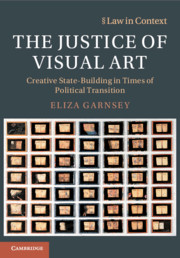Book contents
- The Justice of Visual Art
- The Law in Context Series
- The Justice of Visual Art
- Copyright page
- Dedication
- Contents
- Figures
- Acknowledgements
- Abbreviations
- 1 Introduction
- 2 Art and Justice in Times of Transition
- Part I Recognising Transitional Justice in the Nation State
- Part II Representing Transitional Justice on the Global Stage
- 7 From Banned to Embraced
- 8 Mapping Political Art-Scapes
- 9 The Art of Representation
- 10 The Cultural Diplomacy of Imaginary Fact
- 11 Conclusion
- References
- Index
8 - Mapping Political Art-Scapes
from Part II - Representing Transitional Justice on the Global Stage
Published online by Cambridge University Press: 17 October 2019
- The Justice of Visual Art
- The Law in Context Series
- The Justice of Visual Art
- Copyright page
- Dedication
- Contents
- Figures
- Acknowledgements
- Abbreviations
- 1 Introduction
- 2 Art and Justice in Times of Transition
- Part I Recognising Transitional Justice in the Nation State
- Part II Representing Transitional Justice on the Global Stage
- 7 From Banned to Embraced
- 8 Mapping Political Art-Scapes
- 9 The Art of Representation
- 10 The Cultural Diplomacy of Imaginary Fact
- 11 Conclusion
- References
- Index
Summary
Chapter 8, Mapping Political Art-Scapes, examines the geo-politics of the International Art Biennale in Venice.It begins by mapping how the Biennale transforms the local city space of Venice into a global art-scape.The Giardini and the Arsenale house the majority of the 85 national pavilions – established member states own art embassies in the Giardini while probationary member states rent exhibition spaces in the Arsenale. Pavilions become proxies through which states present an image of themselves to the international community. I contrast South Africa’s 2013 national pavilion with that of the United Arab Emirates (the two states shared an exhibition space in the Arsenale) in order to show how comparisons between states are forced upon them by virtue of exhibiting in the Biennale. I argue that these art-scapes provide fertile ground for states to offer an image of themselves – images which are not necessarily perceived how states intend.
Keywords
- Type
- Chapter
- Information
- The Justice of Visual ArtCreative State-Building in Times of Political Transition, pp. 157 - 167Publisher: Cambridge University PressPrint publication year: 2019

